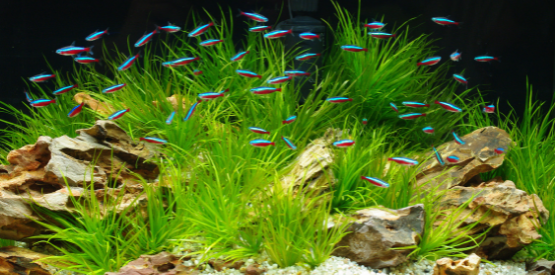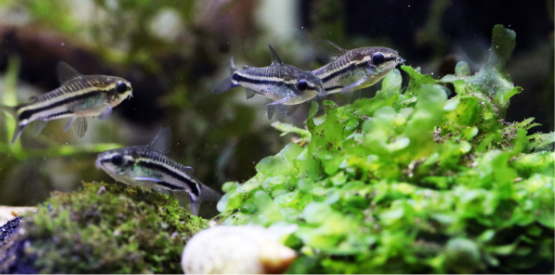The Ins and Outs of Schooling Fish
If you want to add excitement and a real WOW factor to any aquarium, then keeping fish that will school or swim together can do just that. Fish that school together, swim in a formation or unison that often looks like a well-practiced dance recital. When they are schooling, when one turns left or right, or up of down, the whole group follows keeping everyone in a tight formation. In the wild the most common reason fish school together is for safety. This inherited behavior continues even after generations of captive breeding.
If you were to select a fish type that are prone to schooling and only place one or two into an aquarium, they will often be shy and would be prone to hide from view. Examples of fish that would display this behavior are neon tetras, cardinal tetras and pygmy corys. However, if you select a larger group of the same fish type and place them into an aquarium their behavior is such that the group will swim openly throughout the entire aquarium. It is the security in numbers that helps them to feel safe and less stressed and swim freely. Remember placing a larger group of a schooling fish type into an aquarium provides aquarium owners a more natural, energetic, and animated aquarium and most importantly the fish themselves are more comfortable.
You’ll also want to select fish based on compatibility, water conditions, and size of the aquarium (based on their adult size). After we decide on the fish type(s) that meet the aforementioned needs, we should consider how many individual fish will make them happy and swim comfortably as a group. Let’s look at some examples:

Neon Tetras (Paracheirodon innesi) and Cardinal Tetras (Characin axelrodi) do best when the group is at minimum 8 to 16 fish. They are both native to the South America Amazon region and prefer water with a pH ≤ 6.5, and very soft water with a General Hardness (GH) < 5° (90 ppm). They are a small peaceful fish that does well with other non-aggressive fish similar of size. Their maximum size is 1.5-2 inches(4-5cm).
Clown Loaches (Botia macracantha) are best to get when small in a group of 5 or more. They are native to Sumatra, Borneo. They can grow quite large at about 12 inches (30cm). As a small fish in the wild they assemble in large schools. When placed as a group of 5 or more at a young age they will often swim as a group and continue to swim out in the open as they grow. They can grow quite large so an aquarium of 75 gallons (300 liters) or larger is advised. They do best with a pH between 6.5 to 7.0, and a GH with a maximum of 10° (179ppm).
White Clouds (Tanichthys albonubes) are a small mountain minnow with a glistening neon sheen running the length of their body. They tend to do best in groups of at least 8 or more. This fish is found naturally in streams in southern China and Hong Kong. Their adult size is 1-2 inches (5cm). They do best in cooler water 74°F (23°C) but can be kept in a warmer tropical aquarium as well. They prefer a pH of 6.0 to 7.0. White Clouds swim in open areas in the aquarium.
Harlequin Rasboras (Rasbora hetermorpha) are tiny peaceful fish from the region surrounding southeastern Thailand. Harlequin rasboras do very well in groups of 6 or more. Their adult size is 2 inches (5cm). It is recommended to keep them in aquariums of 10 gallons (40 liters) or more. The coloration of the Harlequin Rasboras in a group reveals a coppery appearance with a distant black triangle starting in the back half of their body extending to their tail. They do best when kept at a pH of 6.5 and with a maximum GH of 10° (179ppm).
Scissor-tailed Rasboras (Rasbora tirlineata) are peaceful fish from Borneo and Sumatra. They are happy in larger groups with at least 6 or more. The adult size is normally about 3 inches (7.6cm). The Scissor-tailed Rasboras provide a contrast with a translucent silvery body unique scissor-like tail accented in orange marked with jet-black markings. They can be kept in aquariums with 10 gallons (40 liters) or more. They do best when kept at a pH of 6.5 and a GH with a maximum of 10° (179ppm).
Rummy-nosed Tetras or Red Tetras (hemigrammus rhodostomus) are peaceful fish with a striking red nose, found naturally in the Amazon delta. The tail fin is unique with black markings, complementing the red nose. The adult size reaches just shy of 2 inches (4.5cm). To keep Rummy-nosed Tetras, it is best to have a group of at least 6 or more. They prefer a pH of 6.5 and soft water with a of GH < 8° (140 ppm). They also do well with other non-aggressive fish similar in size.
Glowlight Tetras (Hemigrammus erythrozonus) are small peaceful fish naturally found in Guyana. The length as an adult is 1.5 inches(4.5cm). The fish has a silvery belly that contrasts well with a sparkling red line from its mouth to its tail and the top of the eye has a glowing red spot. When they swim in a group their beauty and charm is apparent. The prefer a pH 6.5 to 7.0 and a GH < 10° (179 ppm). They will do well in a group of 6 or more.
Bloodfin Tetras (Aphyocharax anisitsi) are commonly found in Argentina. The full length as an adult is 2 inches (5cm). They prefer a pH of 6.0 to 7.0 with a GH < 8° (140 ppm). The body of the fish is greenish-silver with back fins showing a deep red that is quite striking. When grouping a selection of 6 or more is advised.
Congo Tetras (Phenacogrammus interrupstus) are naturally found in central Africa. As an adult fish there is no fish that is more striking while providing a prismatic sheen on the sides of their bodies. The males develop a unique tail fin shape with an elongated center fringed in black. Congo Tetras can grow to 3.5 inches (8.5cm). They need extra room and do best in aquariums of 25 gallons (100 liters) or more. They can be kept in a small group of 4 but will do better with a group of 8 or more. The preferred pH is 6.5 with a GH of < 10° (179ppm).
Cherry Barbs or Iridescent Barbs (Capoeta titteya) are naturally found in shaded brooks and lowland rivers of Sri Lanka. They can grow up to 2 inches (5cm) and prefer larger groups of 8 or more. This fish is different in that while they prefer to be around their own type, they do not assemble in schools as freely and remain scattered rather than assembled, however they are a peaceful species. Providing a larger grouping allows them to comfortably swim through the aquarium where they will school on occasion. Their coloration provides many variations from a light pink to a raspberry red with a heavy dark stripe from the tip of the nose to their tail. They do well in a pH 6.5 to 7.0. As they remain small in size, they can be aquarium as small as 10 gallons (40 liters).
Zebra Danios (Danio rerio) are naturally found in eastern India. The maximum length can reach 2.5 inches (6cm). They are tolerant of a wide range of water conditions with a pH range between 6.8 to 8.5and GH between 4° to 11° (75 to 200 ppm). They are a very peaceful fish in large groups and will do best when 8 or more are kept together. When kept in smaller numbers, they are known to display a slightly aggressive behavior, associated with establishment of territories and dominance hierarchies. They can be kept in smaller aquariums, even in large groups, with the preferred size of 10 gallons (40 liters) or larger.

Pygmy Corys (Corydoras pygmaeus) are primarily found in in the South American Amazon in Brazil. Corys can live alone in an aquarium but will mostly hide, however when several corys are placed into an aquarium they become more active and their swimming behavior more evident. Unlike other catfish, Pymgy corys will swim together in all areas of the aquarium as a group a few inches off the bottom. Their full-sized length is 1 inch (2.5cm) and they do best when kept in community aquariums together with other small non-aggressive fish. Cory’s prefer water with a pH ≤ 6.5, and very soft water with a GH < 5° (90 ppm). When groups of 4 or more are kept together a common group swimming is often observed, but larger groups create even more enjoyment.
Red Rainbow Fish (Glossopepis incisus) are found in norther New Guinea. They can reach a full-sized length of 6 inches (15cm). As a larger fish they prefer an aquarium 29 gallons (130 liters) in size, and more so in even larger aquariums. A grouping 8 or more shows off their magnificent colors with mature males showing a deep red throughout their body and mature females with a more yellow reddish hue. They prefer a pH 7.0 to 7.5. This fish does not do well in soft water and does best when aquarium salt is added to the water.
Platys group (Xiphophorus maculatus) are found on the Atlantic coasts of Mexico, Guatemala and Honduras. The color variations are plentiful, and many hybrids are available with many common names such as Coral Platy, Wagtail Platy, Spitz Platy, Simpson Platy and many more. The males are smaller and reach 1.5 to 2 inches (3.5 to 5cm). The females are larger and reach up to 2.5 inches (6cm). Both the females and males can bring full colors to any aquarium. They do well in groups of 8 or more with a ratio of 1 male for every 3 females. They prefer a pH 7.0 to 7.5. This fish does not do well in soft water and does best when aquarium salt is added to the water. They can be kept in smaller aquariums starting at 10 gallons (40 liters).
These are just a few examples of fish that do better in groups than a solitary pair or alone. Providing fish with the benefit of larger groups we are more likely to witness their natural behaviors when kept in aquariums and having them less stressed. Having a group of fish coordinate their swimming and seeing the shimmering in the water as the group swims together makes any aquarium experience even more enjoyable. The most important fact is that the fish will be more comfortable and less stressed. Making selections that are best for our fish provides a more active aquarium and the fish are more protected, yielding years of enjoyment for all that view the aquarium and for your fish.
